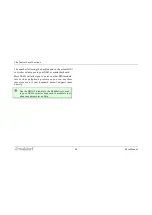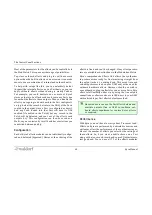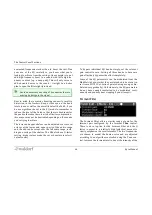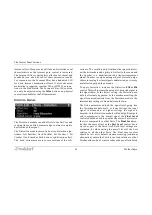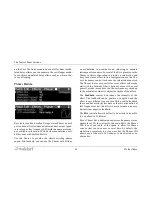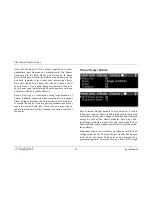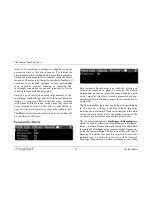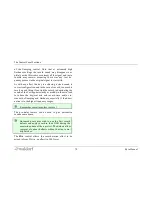
The Control Panel Sections
64
Kyra Manual
unwanted frequencies rather than to boost the rest. Plan
your use of the EQ carefully so you know what you’re
looking to achieve from the settings. One example is to not
add high frequency boost to a sound with little high fre-
quency content (e.g. a deep pad). This will only serve to
add unwanted noise to the sound – it might be a better
plan to open the filter slightly instead.
g
Avoid unnecessary boosting of frequencies that are
missing by design in the signal.
Bear in mind that excessive boosting can easily result in
distortion in the Limiters. Keep a close eye on the boost
levels in use as well as the overall levels of the Patch; if you
do use significant boost in the EQ module, remember to
reduce the level of the Patch so that there is headroom for
the peaks otherwise there is a risk of limiter compression -
this may or may not be desirable depending on the sounds
you're trying to achieve.
The lower and upper shelves can be adjusted over several
octaves of the lower and upper parts of the audio range
and the mid can be swept over the full audio range, inclu-
ding an overlap of the shelves. The Mid also has a Q-factor
setting - higher values make the cut or boost more selecti-
ve (narrower).
To bypass individual EQ bands, simply set the relevant
gain control to zero. Setting all three bands to have zero
gain effectively bypasses the effect completely..
Some of the EQ parameters can be modulated from the
Mod Matrix but note that they are intended to be static (i.e.
set from a MIDI CC at various points during a song or mo-
dulated very gradually). Unfortunately, the EQ parameters
do not have enough resolution to be modulated conti-
nuously and you may hear stepping if you attempt it.
Formant Filter
The Formant Filter offers a similar range of gain for the
formant pair configured by the formant
Tune
control.
There is no cut option for the Formant Filter and the Q
factor is preset to a relatively high (selective) amount to
clearly emphasise the vocal formants. The two frequencies
are chosen to model the human voice and are adjusted
according to an algorithm controlled using the Tune con-
trol. Increase the formant level to boost the intensity of the











